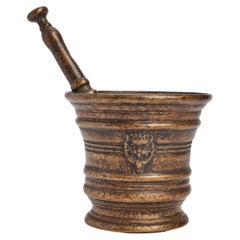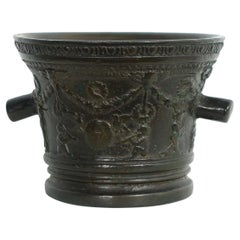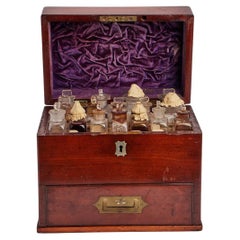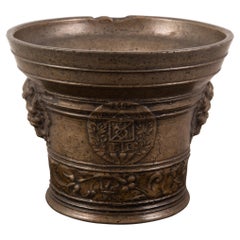18th Century and Earlier Scientific Instruments
to
14
101
38
140
20
19
9
6
2
1
1
1
1
140
598
821
8
384
285
62
27
45
35
37
33
54
36
23
10
72
56
30
26
23
121
36
33
21
14
140
140
140
3
3
2
1
1
Period: 18th Century and Earlier
An apothecary bronze mortar and pestle, Italy 1700.
Located in Milan, IT
Bronze Apothecary mortar, fitted with mortar pestle. Italy early 18th century.
Category
Italian Antique 18th Century and Earlier Scientific Instruments
Materials
Bronze
18th Century French Giltwood and Ebonized Barometer with Floral Crest
Located in New York, NY
A magnificent 18th-century French barometer showcasing a masterful combination of giltwood and ebonized wood. The elegant frame features intricate hand-carved detailing, including a ...
Category
Antique 18th Century and Earlier Scientific Instruments
Materials
Wood
Bronze Mortar, Tuscany, Second Half of 16th Century
Located in Bruxelles, BE
Bronze mortar with garlands, flowers and putti - Tuscany , second half of 17th century.
Measures: height 10
diameter : 13 cm
Artisans and healers used mortars for grinding food...
Category
Italian Renaissance Antique 18th Century and Earlier Scientific Instruments
Materials
Bronze
Travel pharmacy in mahogany wood and brass, England 1790.
Located in Milan, IT
Travel pharmacy. Box in Mogano Sipo ( Entandrophragma utile ) wood and brass with recessed handles on both sides and a drawer on the front. The upper level opens, inside it there are...
Category
English Antique 18th Century and Earlier Scientific Instruments
Materials
Brass
Flemish mortar. Bronze. 17th century.
Located in Madrid, ES
Flemish mortar. Bronze. XVII century.
Features brand.
Mortar with a circular base with a mouth that extends outward from the two upper stripes and a body with slight entasis and a ...
Category
European Baroque Antique 18th Century and Earlier Scientific Instruments
Materials
Bronze
18th Century French Louis XVI Carved Giltwood Wall Barometer & Thermometer
Located in Dallas, TX
Decorate a wall with this elegant, antique barometer with attached thermometer. Crafted in Paris, France, circa 1760 and hexagonal in shape, the scientific instrument features its or...
Category
French Louis XVI Antique 18th Century and Earlier Scientific Instruments
Materials
Glass, Giltwood, Parchment Paper
Late 18th Century Silver Dutch Perpetual Calender
Located in Lymington, Hampshire
A rare late 18th-early 19th century silver Dutch perpetual calendar.
Category
Dutch Antique 18th Century and Earlier Scientific Instruments
Materials
Silver
Louis XVI Gilt-Wood Barometer & Thermometer, France c. 1780
Located in Atlanta, GA
A Louis XVI Period Barometer & Thermometer Combination, originating in France & dating from the last quarter of the 18th century. The workings enclosed by a gilt-wood case with carve...
Category
French Louis XVI Antique 18th Century and Earlier Scientific Instruments
Materials
Glass, Giltwood
French 18th Century Louis XVI Period Giltwood Barometer Thermometer
Located in West Palm Beach, FL
An elegant and extremely decorative French 18th century Louis XVI period giltwood barometer thermometer. The most decorative barometer thermometer retains its original glass pane enc...
Category
French Louis XVI Antique 18th Century and Earlier Scientific Instruments
Materials
Giltwood
Rare George III Celestial Pocket Globe by Cary, London
By Cary
Located in Oxfordshire, United Kingdom
A fine and rare 3" celestial pocket globe by G & W Cary, Strand, London circa 1791, housed in its original sharkskin case.
A companion globe to terrestrial globes of this type we...
Category
English George III Antique 18th Century and Earlier Scientific Instruments
Materials
Plaster
Ebony, brass and ivory pantograph, signed Lennel, Paris 1780.
Located in Milan, IT
Brass and ebony wood pantograph, in its original mahogany box. The wheels are made of ivory. The instrument shows the signature of the maker Lennel à La Sphére à Paris. France 1780. ...
Category
French Antique 18th Century and Earlier Scientific Instruments
Materials
Brass
Antique Albertus Seba Pair 18th Century Hand-Colored Engravings Butterfly
Located in Washington, DC
Rare pair of original hand-colored prints from Sir Albertus Seba's cabinet of natural curiosities. Prints come from published volumes in Amste...
Category
Dutch Antique 18th Century and Earlier Scientific Instruments
Materials
Paper
18th Century Silver Butterfield Dial By Langlois Paris
By Pierre Langlois
Located in Lincolnshire, GB
A fine example of a silver Butterfield type sundial in the original green shagreen case. The finely engraved dial has Premier cadran (first dial) engraved with the city names and lat...
Category
French Antique 18th Century and Earlier Scientific Instruments
Materials
Silver
18th Century English Mahogany Cased Stick Barometer by Dolland of London
By Dolland
Located in Dublin, IE
An exceptional late 18th century mahogany cased stick barometer by Dolland of London, The mahogany case of a very solid construction and with a superbly made turned mahogany cistern ...
Category
English Georgian Antique 18th Century and Earlier Scientific Instruments
Materials
Steel
16th century Spanish Bronze Mortar with Letters M on the Sides
Located in Marbella, ES
16th century Spanish Bronze Mortar with Letters M on the Sides
Category
Spanish Antique 18th Century and Earlier Scientific Instruments
Materials
Bronze
18th Century Stick Barometer by Nairne London
Located in Lincolnshire, GB
An elegant 18th century satinwood and ebony stick barometer by Edward Nairne, London.
Nairne was a famous 18th century scientific instrument and barometer...
Category
English Antique 18th Century and Earlier Scientific Instruments
Materials
Ebony, Satinwood
large apothecary's ivory mortar - 17th century
Located in Bruxelles, BE
Large apothecary's ivory mortar
Indo-Portuguese
17th century
16,7 x 10,4 cm
Cites certificate number 2022/BE01446/CE
Category
Indian Renaissance Antique 18th Century and Earlier Scientific Instruments
Materials
Ivory
Mortar and pestle. Bronze. 15th century.
Located in Madrid, ES
Mortar and pestle. Bronze. 15th century.
Bronze mortar and pestle with a circular base and a spouted mouth decorated with a band beneath the rim. The base, facing outward, features...
Category
European Gothic Antique 18th Century and Earlier Scientific Instruments
Materials
Bronze
George III Oversized Magnifying Glass Late Circa 1790
Located in Bishop's Stortford, GB
George III Oversized Magnifying Glass Late Circa 1790. Comprised of a turned mahogany surround holding 20 cm lens with a turned mahogany handle connected by a generous brass ferrule ...
Category
European George III Antique 18th Century and Earlier Scientific Instruments
Materials
Brass
17th Century Tripod Apothecary Skillet Dated 1698 from The Ward Rvmens Family
Located in Brussels, Brussels
17th century tripod apothecary skillet dated 1698 by Ward Rymens.
The skillet is in superb condition and has had a restoration on one of the feet.
bronze with a very beautiful patina.
Category
British Georgian Antique 18th Century and Earlier Scientific Instruments
Materials
Bronze
Tripod Apothecary Skillet Late 17th-Early 18th Century, England
Located in Brussels, Brussels
Apothecary tripod skillet from the end of the 17th century beginning of the 18th century From England.
The skillet is in superb condition and has not undergone any restorations.
Br...
Category
British Georgian Antique 18th Century and Earlier Scientific Instruments
Materials
Bronze
17th century apothecary's ivory mortar and pestle - Germany
Located in Bruxelles, BE
large 17th century turned apothecary's ivory mortar and pestle
Germany
17th century
Cites certificate number IT/CE/2023/MI/01110
18,6 x 7 cm ; pestl...
Category
German Renaissance Antique 18th Century and Earlier Scientific Instruments
Materials
Ivory
A GERMAN ANATOMICAL MODEL OF a PREGNANT WOMAN STEPHEN ZICK
Located in Madrid, ES
A GERMAN ANATOMICAL MODEL OF A PREGNANT WOMAN STEPHEN ZICK
The woman with articulated arms, removable torso revealing internal organs, lying on a couch with cushion incised and modelled with simulated lace.On a later wood box.
Stephen Zick was one of a dynasty of carvers active from the late 16th to the 18th century in Nuremberg, . Such models, as well as carved skulls, were conceived as teaching tools and were inspired by the drawings of Andrea Vesalius...
Category
Antique 18th Century and Earlier Scientific Instruments
Materials
Wood
Antique 18th Century Trebuchet, Money Changer's Balance, With Its Weights
Located in Bilzen, BE
Wooden trebuchet with its weights.
These kind of scales were used by money changers to weigh golden coins in those days to avoid fraud
18th Century
The box measures 18 cm X 8.7 cm ...
Category
German Industrial Antique 18th Century and Earlier Scientific Instruments
Materials
Brass, Wrought Iron
Antique Roman Bronze Rare Architects Geometrical Compass/Divider 3.AD
Located in Doha, QA
Extremely rare and one of a kind ancient Roman bronze geometrical compass/divider. It is in an excellent condition for its age. The Compass is displayed on a dark marble block with a...
Category
Italian Classical Roman Antique 18th Century and Earlier Scientific Instruments
Materials
Stone, Bronze
Louis XIV marble herbalist, France 17th century.
Located in Milan, IT
Rare Marble herbalist to hold salt, moon and stars carved on the wavy front. The lid is lead, with the image of the sun and lions. Louis XIV period, France 1600.
Category
French Antique 18th Century and Earlier Scientific Instruments
Materials
Marble, Pewter
Occasus Ortus: An Astronomical Measuring Device for Angular Precision, c.1780
Located in Langweer, NL
This print, titled "Occasus Ortus", showcases a highly detailed engraving of an 18th-century measuring device, likely related to astronomy or navigation.
The design features various components of the instrument arranged systematically, with each part labeled by figure numbers. The centerpiece is a large circular protractor...
Category
Antique 18th Century and Earlier Scientific Instruments
Materials
Paper
Lignum Vitae Treen Vices Pair of Minature Tree of Life
Located in BUNGAY, SUFFOLK
- Collector's specimens
- Lignum vitae is sought after for the beauty of its grain, coloring, patina, density and toughness
Translated from Latin, vignum vitae means “wood of lif...
Category
English George II Antique 18th Century and Earlier Scientific Instruments
Materials
Wood
French Late 18th Ormolu and Sèvres Porcelain Barometer, Signed Giroux
Located in West Palm Beach, FL
An most elegant and extremely high quality French late 18th/ beginning of the 19th century, ormolu and Sèvres porcelain barometer, signed Giroux. The barometer has a central bottom a...
Category
French Antique 18th Century and Earlier Scientific Instruments
Materials
Ormolu
Good 18th Century Bronze Sundial By Miller And Adie, Edinburgh
Located in Lincolnshire, GB
A finely engraved 18th century, 15" diameter bronze sundial signed Miller & Adie, Edinburgh with good patina and the original gnomon.
Category
Scottish Antique 18th Century and Earlier Scientific Instruments
Materials
Bronze
17th Century Spanish Talavera Pharmacy Jar in Blue Glazed Ceramic
Located in Marbella, ES
17th Century Spanish Talavera pharmacy jar in blue glazed ceramic.
Category
Spanish Antique 18th Century and Earlier Scientific Instruments
Materials
Ceramic
18th Century Medical Syringe
Located in London, GB
18th Century Medical Syringe
For historical medical use and dating from the 18th century, and certainly from the beginning of the 18th century. This hand-crafted example is made to...
Category
Unknown Antique 18th Century and Earlier Scientific Instruments
Materials
Natural Fiber
18th Century Italian Bronze Pestle for a Mortar, 9 Inches Long
Located in Stamford, CT
If you've got the mortar, I have the pestle! There are so many mortars out there, and so few pestles. It's nice to have both. Here is your opportunity to marry this large scale pestl...
Category
Italian Baroque Antique 18th Century and Earlier Scientific Instruments
Materials
Bronze
Antique Apothecary Mortar & Pestle, English, Bronze, Chemist Shop Aid, Georgian
Located in Hele, Devon, GB
This is an antique apothecary mortar and pestle. An English, bronze chemist's shop aid, dating to the Georgian period, circa 1800.
Quality Georgian apothecary aid with superb finis...
Category
British Georgian Antique 18th Century and Earlier Scientific Instruments
Materials
Bronze
Very Rare Wind Vane Dial in the Manner of Whitehurst
Located in Lincolnshire, GB
A George III period carved mahogany wind vane dial. The silvered engraved dial with all the points of a compass housed in the finely carved mahogany frame, ...
Category
English Antique 18th Century and Earlier Scientific Instruments
Materials
Glass, Mahogany
Alnmått (Cubit measure) in Birch with a Noble Crown. Gustavian, dated 1783
Located in Knivsta, SE
Rare Alnmått (Cubit measure) made in Birch with a Noble Crown. From the Gustavian period of the late 1700s, roughly corresponding to the Louis XVI period in France, made in Sweden an...
Category
Swedish Gustavian Antique 18th Century and Earlier Scientific Instruments
Materials
Brass
Louis XV Parcel-Gilt And Painted Wood Barometer
Located in Bradenton, FL
18th century Louis XV period hand carved and painted parcel gilt French wall barometer. Louis XV giltwood case with ornately hand-carved scrollwork on a green painted wood back. A be...
Category
French Louis XV Antique 18th Century and Earlier Scientific Instruments
Materials
Wood, Glass
French Bronze Mortar, Early 17th Century
Located in Spencertown, NY
The mortar with fleurs de lys decoration.
Category
French Baroque Antique 18th Century and Earlier Scientific Instruments
Materials
Bronze
Anatomical model: a thyroid, Germany end of 18th century.
Located in Milan, IT
Coloured wax anatomic model depicting an human organ: Thyroid mounted on black painted wooden base. Germany end of XVIII sec.
Category
German Antique 18th Century and Earlier Scientific Instruments
Materials
Wood
Alnmått (Cubit measure) in iron with gilded details. Baroque, dated 1731
Located in Knivsta, SE
Swedish Alnmått (Cubit measure) in iron with gilded details. Baroque, dated 1731. Provenance: Baron Carl Emanuel Cederström, great collector during the mid-19th Century in Sweden.
W...
Category
Swedish Baroque Antique 18th Century and Earlier Scientific Instruments
Materials
Iron
Late Medieval Marble Apothecary Mortar
Located in Pease pottage, West Sussex
Marble apothecary mortar. with four lugs having being worked into horses heads. Most likely for private apothecary use Excellent patination. Marble C...
Category
Italian Antique 18th Century and Earlier Scientific Instruments
Materials
Marble
Antique George III Quality Mahogany Banjo Barometer
Located in Suffolk, GB
Antique George III quality mahogany banjo barometer having a swan neck pediment, original thermometer and an engraved circular silvered dial with original hands and brass bezel, qual...
Category
English George III Antique 18th Century and Earlier Scientific Instruments
Materials
Mahogany
18th Century Gold French Gilded Wood Barometer, Antique Parisian Thermometer
Located in West Palm Beach, FL
A rare antique finely worked French barometer with lyre shaped crest thermometer above a large hexagonal framed barometer. The Parisian décor piece is m...
Category
French Empire Antique 18th Century and Earlier Scientific Instruments
Materials
Giltwood
Italian-transalpine time dial paper on wood board. Giusti, Nerici, Italy 1781.
Located in Milan, IT
An Italian and transalpine hour dial in paper printed on a fruitwood board. The base, in turned boxwood, has a wavy profile and distinct edge, at the top of which is mounted the rect...
Category
Italian Antique 18th Century and Earlier Scientific Instruments
Materials
Brass
18th Century French Louis XVI Giltwood Barometer
Located in Sheffield, MA
A stunningly beautiful 18th century French gold gilt barometer is a weather instrument with mercury-filled glass thermometer still in working order...
Category
French Louis XVI Antique 18th Century and Earlier Scientific Instruments
Materials
Wood
Rare Antique Engraving of Microscopes, 1749
Located in Langweer, NL
Antique print titled 'A true Representation of sveral microscopes with some objects (..)'. Print of various microscopes, illustrating several microscope parts. This print originates ...
Category
Antique 18th Century and Earlier Scientific Instruments
Materials
Paper
Antique Print of a Scientific Instrument, 1769
Located in Langweer, NL
Antique print titled 'A curious Instrument which shews the Hour of the Day (..)'. Print of a scientific instrument. This print originates from 'The Gentleman's Magazine'.
Artists a...
Category
Antique 18th Century and Earlier Scientific Instruments
Materials
Paper
Antique Original Engraving of Seasons by Le Bas, C.1780
Located in Langweer, NL
Antique astronomy print titled 'L'inégalité des Saisons et des Jours'. Interesting print explaining why there is an inequality in the length of days and seasons. Source unknown, to b...
Category
Antique 18th Century and Earlier Scientific Instruments
Materials
Paper
Antique Print of Two Balances for Weighing Fire and Air, c.1780
Located in Langweer, NL
Antique print titled 'Balance for weighing air - Balance for weighing fire'. Copper engraving of two balances. Source unknown, to be determined.
Artists and Engravers: Anonymous
...
Category
Antique 18th Century and Earlier Scientific Instruments
Materials
Paper
Late 18th Century French Giltwood Barometer
Located in Essex, MA
Period late 18th century giltwood barometer. Original gilding. Carved overall with globe, and navigation instruments. Foliate and neoclassical motifs. Maker signed.
Category
French Louis XVI Antique 18th Century and Earlier Scientific Instruments
Materials
Giltwood
Antique Print of a New Water Exhausting Machine, 1758
Located in Langweer, NL
Antique print titled 'A New Machine for exhausting a large quantity of water'. Print of a new water exhausting machine. This print originates from 'The Universal Magazine...
Category
Antique 18th Century and Earlier Scientific Instruments
Materials
Paper
Trio Of Antique Mortars, English, Bronze, Apothecary Pot, William III, C.1700
Located in Hele, Devon, GB
This is a trio of antique mortars. An English, bronze apothecary instrument, dating to the William III period, circa 1700.
Charming trio, ideal for decorative display or as planting...
Category
British William and Mary Antique 18th Century and Earlier Scientific Instruments
Materials
Bronze
18th Century French Louis XVI Giltwood Barometer
Located in Houston, TX
Lovely period French Louis XVI giltwood barometer with beautiful patina. This antique French Louis XVI gilt wood barometer will add a touc...
Category
French Louis XVI Antique 18th Century and Earlier Scientific Instruments
Materials
Giltwood
18th Century English Treen Yew Wood Mortar and Pestle
Located in Stamford, CT
18th century English treen mortar and pestle hand turned and carved from yew wood with the rich and warm patina that only comes with age and use. Beautifully carved by hand from a si...
Category
English Georgian Antique 18th Century and Earlier Scientific Instruments
Materials
Yew
17th Century Norther European Wrought Iron Pestle, 8.5 Inches
Located in Stamford, CT
Unusual wrought iron pestle, most are bronze like most mortars. This one is at least 17th century, quite possibly dating to the Gothic period. I have owned two iron mortars in my ti...
Category
German Baroque Antique 18th Century and Earlier Scientific Instruments
Materials
Wrought Iron
Pair 17th Century Medical Anatomy Engravings by Francesco Valesio, 1627
Located in Rochester, NY
Two anatomical copper engravings by Francesco Valesio. From De humani corporis fabrica libri decem
Evangelista Deuchino, Venice: 1627. Laid paper.
Category
European Antique 18th Century and Earlier Scientific Instruments
Materials
Paper
18th Century French Louis XVI Giltwood Barometer
Located in Sheffield, MA
A stunningly beautiful 18th century French gold gilt barometer is a weather instrument with mercury-filled glass thermometer still in working order...
Category
French Louis XVI Antique 18th Century and Earlier Scientific Instruments
Materials
Wood
A Brass Butterfield Type Dial French Early 18th Century
Located in Firenze, IT
signed Buterfield A Paris., the octagonal dial with hinged gnomon and bird pointer, inset compass and engraved with hour scales, the reverse engraved with towns and their latitudes, ...
Category
French Napoleon III Antique 18th Century and Earlier Scientific Instruments
Materials
Brass





